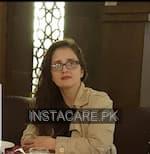Endometriosis - Symptoms, Risk factors and Treatment
Last Updated On Saturday, July 5, 2025
Endometriosis in Urdu
اینڈومیٹرائیوسس خواتین کے تولیدی نظام کا اکثر تکلیف دہ عارضہ ہے جس میں بچہ دانی کے اندر کی لکیروں سے مشابہ ٹشو اس کے باہر اگتا ہے۔ بچہ دانی کی اندرونی استر کو اینڈومیٹریئم کے نام سے جانا جاتا ہے۔ جب یہ بچہ دانی کے باہر بڑھتا ہے تو یہ غیر معمولی ہوتا ہے اور بعض اوقات تکلیف دہ ہو سکتا ہے۔ مزید یہ کہ یہ حاملہ ہونے میں بھی رکاوٹ بن سکتا ہے۔ اس میں بیضہ دانی، فیلوپین ٹیوبیں اور شرونی کی بافتوں کی پرت شامل ہو سکتی ہے۔ تاہم، بعض اوقات یہ شرونیی اعضاء سے باہر بھی پھیل سکتا ہے۔
عام حالات میں، اینڈومیٹریئم گاڑھا ہونا ٹوٹ جاتا ہے اور ہر ماہ خون بہنے لگتا ہے۔ جب اس سے مشابہ ٹشو بچہ دانی کے باہر بڑھتا ہے تو یہ اینڈومیٹریئم کی طرح برتاؤ بھی کرتا ہے۔ یہ گاڑھا ہونے، ٹوٹنے اور خون بہنے کی بھی کوشش کرتا ہے۔ لیکن آخرکار اس کا جسم سے باہر نکلنا ممکن نہیں ہوتا۔ اس کی وجہ سے یہ جسم کے اندر پھنس جاتا ہے۔ پھنسے ہوئے ٹشو ارد گرد کے ٹشوز اور اعضاء کو پریشان کرتے ہیں، جس سے داغ کی نشوونما اور چپکنے کا باعث بنتا ہے، جس کے نتیجے میں اعضاء آپس میں چپک جاتے ہیں۔ جب اینڈومیٹرائیوسس میں بیضہ دانی شامل ہوتی ہے تو سسٹ کہلاتے ہیں، اینڈومیٹریومس بن سکتے ہیں۔ Endometriosis بعض اوقات انتہائی تکلیف دہ ہو سکتا ہے، خاص طور پر ماہواری کے دوران۔ یہ زرخیزی کے مسائل کا بھی سبب بن سکتا ہے۔ لیکن خوش قسمتی سے، علاج اس کے ساتھ مدد کر سکتا ہے.
Endometriosis in English
Endometriosis is an often painful disorder of the female reproductive system in which the tissue resembling the one that lines inside of the uterus grows outside it. The inner lining of the uterus is known as the endometrium. When it grows outside the uterus, it is abnormal and can become painful at times. Moreover, it may hinder conception as well. It can involve the ovaries, fallopian tubes, and tissue lining of the pelvis. However, at times it may also spread beyond pelvic organs.
Under normal conditions, the endometrium thickens breaks down and bleeds every month. When a tissue resembling it grows outside the uterus, it also behaves like an endometrium. It also tries to thicken, break and bleed. But it is eventually not possible for it to get out of the body. Due to this, it gets trapped inside the body. The trapped tissue irritates the surrounding tissues and organs, leading to scar development and adhesion, which in turn cause the organs to stick together. When endometriosis involves the ovaries, cysts called, endometriomas may form. Endometriosis can become highly painful at times, especially during menstrual periods. It can also cause fertility problems. But fortunately, treatment can help with it.
Symptoms
The most common symptom of endometriosis is pelvic pain that exacerbates during the menstrual period. Under normal conditions, most women have pelvic pain during the menstrual cycle. But females with endometriosis describe it much more than usual pain associated with menstrual periods.
The signs and symptoms of endometriosis are;
- Dysmenorrhea- painful periods
- Pain during bowel movement
- Pain during urination
- Pain during or after sexual intercourse
- Excessive menstrual bleeding or bleeding that occurs between the menstrual cycle
- Infertility or difficulty in conception
- Extreme menstrual pain
- Fatigue
- Diarrhea
- Constipation
The severity of pain is not an indicator of endometriosis extent. It may be possible that one woman does not have much pain, but her endometriosis has reached the advanced stage. And it may be also possible that a person having so much pain has not much abnormal tissue growth outside the uterus. Also, it is often confused with other diseases like inflammatory bowel disease or ovarian cysts.
Causes
The exact cause of endometriosis is unknown. But some of them can be;
- Retrograde menstruation
- Embryonic cell transformation
- Transformation of peritoneal cells
- Surgical scar implantation
- Endometrial cell transport
- Immune system disorder
Risk Factors
The risk factors for endometriosis are;
- A woman who has never given birth
- Periods starting at an early age
- Going through menopause at an older age which eventually increases lifetime exposure to estrogen
- Having short menstrual cycles like less than 27 days
- Heavy menstrual periods that last longer than seven days
- Any medical condition that prevents the normal passage of menstrual flow out of the body
- Reproductive tract abnormalities
- Having higher levels of estrogen in your body or greater lifetime exposure to estrogen your body produces
- Low body mass index
- One or more relatives (mother, aunt, or sister) with endometriosis
Conclusion
Endometriosis is an often painful disorder of the female reproductive system in which the tissue resembling the one that lines inside of the uterus grows outside it. The inner lining of the uterus is known as the endometrium. When it grows outside the uterus, it is abnormal and can become painful at times. Moreover, it may hinder conception as well. It can involve the ovaries, fallopian tubes, and tissue lining of the pelvis. However, at times it may also spread beyond pelvic organs. The most common symptom of endometriosis is pelvic pain that exacerbates during the menstrual period. Under normal conditions, most women have pelvic pain during the menstrual cycle. But females with endometriosis describe it much more than usual pain associated with menstrual periods.
Frequently Asked Questions
Endometriosis meaning in urdu is ایسی حالت جس میں رحم اپنی جگہ سے ہٹ جائے.
The exact cause of endometriosis is unknown, but there are several theories. The most widely accepted theory is retrograde menstruation, which suggests that during a woman’s menstrual cycle, some of the endometrial cells that are shed travel up through the fallopian tubes, into the abdomen, and attach to other organs. Other factors that may increase a woman’s risk of developing endometriosis include having a family history of the disease, having a shorter menstrual cycle, and having higher levels of estrogen hormones in the body.
The three main symptoms of endometriosis are: 1) Painful periods; 2) Pain during or after sex; and 3) Heavy periods or spotting between periods. Other symptoms can include abdominal cramps, fatigue, and difficulty getting pregnant.







